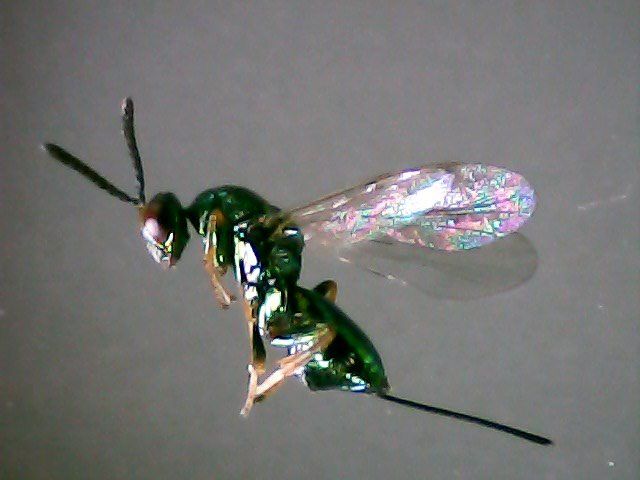Torymus sinensis Kamijo - Biological Control of Chestnut Gall Wasp
Introduction
In 1976, Murakami et al. (1977) found a species of Torymus from the galls of chestnut gall wasp Dryocosmus kuriphilus
Yasumatsu collected in China. After preliminary release test, they proposed the introduction of this parasite into Japan for the biological control of the chestnut gall wasp. In August 1979, many galls collected in Hopei Province, China, were imported into Japan and the progeny of Torymus which emerged from those galls is being propagated in the Fruit Researche Station, Ibaraki-ken, and Kyushu University, Fukuoka (Murakami, 1981). Yasumatsu and Kamijo (1979:97) pointed out that the species recorded under the name of Torymus beneficus
Yasumatsu from Korea by Pak (1963) differs from beneficus in several characters. So, Kamijo (Kamijo, 1982) described it as a new to science and as parasitic on the chestnut gall wasp. Since last '80s in Japan the introduction and the settlement of Torymus sinensis
Kamijo as agent to control Dryocosmus kuriphilus reduced gall wasp population down to damage level. Costant extention of distribution area and the dispersion speed and the results that Torymus sinensis had shown make introduction of this parasitoid the most important tecnique of biological control of a pest ever registered in Japan (Piao and Moriya, 1999).
Morphology & Biology
Torymus sinensis
has one generation a year and it consists in female and male individuals. Female has a 1.9-1.7 mm body length, bluish green with coppery and bronzy reflections (first tergite deep blue), scape yellowish brow (darker apically); pedicel blackish with a metallic tinge; flagellum dark brown. Coxae and femora are concolour with thorax and boh tips of femora are more or less brownish; hind tibiae are broadly brown to metallic green, with both tips lighter. Fore and mid tibiae are yellowish brown, dorsally darker medially, tarsi are yellowish, with last segment darker and tegulae are bluish green. Wings are hyaline and veins are brownish yellow. Ovipositor sheaths are distinctly longer than head plus thorax, or 1.34 to 1.54 times length of thorax. Male differs from female as follows: 1.7-2.1 mm body length, scape blackish with metallic reflections, tibiae extensively darker, usually with metallic reflections (Kamijo, 1982)
The only Torymus sinensis
generation emerges roughly in April. In early spring, adults emerge from withered galls on chestnut trees formed in the previous year, and females oviposit in newly formed galls. The eggs are deposited in the larval chamber of the gall (occupied by Dryocosmus kuriphilus
larvae). The host was stung and paralized by the female parasitoid at the time of deposition. The fisrt instar larva feeds on the soft plant tissue of the chamber wall. Two or more eggs are frequently laid in a gall chamber but only one larva can survive. The supernumeraries are eliminated in early stages. After the larva develops to the second instar, it feed ectoparasitically on the mature larvae of the chestnut gall wasp. After a month, the parasitoid develops mature larva and enters a long diapause until autumn in the gall chamber. During winter it pupates and emerge in early spring (Murakami, 1981). Only fecundated females will get a heterogeneous generation (female and male individuals), otherwise it will only males in the next generation.


References
- Murakami Y. (1981), The parasitoids of Dryocosmus kuriphilus
Yasumatsu (Hymenoptera: Cynipidae) in Japan and the introduction of a promising natural enemy from China (Hymenoptera: Chalcidoidea), J. Fac. Agr., Kyushu Univ., 25: 167-174
- Yasumatsu K. & Kamijo K. (1979), Chalcidoid parasites of Dryocosmus kuriphilus Yasumatsu /Cynipidae) in Japan, with description of five new species (Hymenoptera), Esakia, Fukuoka, (14): 93-111
- Pak S. (1963), Studies on the natural enemies of chestnut gall wasp (dryocosmus kuriphilus Yasumatsu) (Part 1). Publ. Divis. Prot., Bureau Forest., Ministry Agr. Forest., Seul, (1): 1-13
- Kamijo K. (1982), The new species of Torymus (Hymenoptera, Torymidae) reared from Dryocosmus kuriphilus (Hymenoptera, Cynipidae) in China and Korea, Kontyu, Tokio, 50: 505-510





